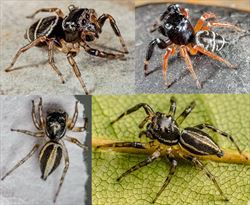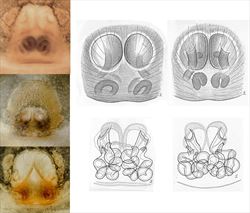
Live specimens of Zenodorus
Illustrators (and ©) I.R. Macaulay (T) & R. Whyte (B)

Aspects of the general morphology of Zenodorus
Illustrators (and ©) R. Whyte (TL), B.J. Richardson (CSIRO), M. Zabka (diag,) (QMB)

Palp morphology of Zenodorus
Illustrators (and ©) B.J. Richardson (CSIRO), M. Zabka (diag,) (QMB)

Epigyne morphology of Zenodorus
Illustrators (and ©) B.J. Richardson (LT) (CSIRO), R. Whyte (LM, LB) & M. Zabka (diag,) (QMB)
Zenodorus Peckham and Peckham, 1891
Taxonomy
Zenodorus has fourteen Australian species, Zenodorus albertisii, Z. arcipluvii, Z. asper, Z. durvillei, Z. jucundus, Z. marginatus, Z. metallescens, Z. niger, Z. obscurofemoratus, Z. orbiculatus, Z. pupulus, Z. semirasus, Z. swiftorum and Z. varicans. A further species, Z. juliae, is found in New Guinea, though erroneously reported from Australia. The genus is widespread in south-east Asia and the south-west Pacific. Zenodorus was previously synonymised with Omoedus (Zhang and Maddison 2012), reinstated by Proszynski, 2017. Further information on the genus and described species can be found in Richardson and Żabka (2017) and Whyte and Anderson (2017).
Description
Zenodorus spp. are small to medium-sized spiders, about 3 to 5 mm in body length. They have a high profile when viewed from the side. When viewed from above, the head is rectangular to triangular often with a distinct anterolateral bulge. The abdomen is rounded to elongate-ovate. Each species has a distinct, often black and white, dorsal pattern. Chelicerae in both males and females are mildly to strongly geniculate (bowed), usually with a single tiny retromarginal tooth (unident) and two teeth opposite on the promargin. The legs are short to long, from slender to stoutly built.
The male’s palp has a pear-shaped cymbium and a rounded to pear-shaped tegulum without a proximal lobe. The embolus forms a tight, small, anticlockwise coil overlapping the distal edge of the tegulum, sometimes circling many times before the tip of the embolus separates to point towards the tip of the cymbium. The retro-lateral apophyses on the male palpal tibiae are extremely slender and fine almost their whole length, which varies. Sometimes the retro-lateral tibial apophysis is absent.
The female has a pair of variously-shaped atria. The copulatory openings are located at the antero-lateral edges of the atria. The insemination ducts travel posteriorly, forming a pair of tubes barely widening into the spermathecae. The highly convoluted spermathecae vary in position, but usually lie between the lower margins of the atria and the epigastric fold.
Biology
Zenodorus is found on all vegetation types and in litter, from grassland to rainforest, many species being common under bark, especially on large eucalypts and allies.
Distribution
In Australia, Zenodorus is widespread and common across the mainland, especially in warmer areas. There are many species in New Guinea and Zenodorus also occurs in the Oriental Region and in the south-west Pacific.
References
Davies, V.T. & Żabka, M. 1989. Illustrated keys to the genera of jumping spiders (Araneae: Salticidae) in Australia. Memoirs of the Queensland Museum 27, 189-266.
Proszynski, J. 2017. Pragmatic classification of the world Salticidae (Aranaea). Ecologica Montenegrina 12, 1-133
Richardson, B.J. & Żabka, M. 2016. Salticidae. Arachnida: Araneomorphae. Canberra, Australian Faunal Directory. Australian Biological Resources Study, at https://biodiversity.org.au/afd/taxa/SALTICIDAE.
Whyte, R. and Anderson, G. (2017). A Field Guide to Spiders of Australia. CSIRO Publishing: Clayton, 451pp.
Zabka, M. 1988. Salticidae (Araneae) of Oriental, Australian and Pacific Regions, III. Annales Zoologici, Warszawa 41, 421-479.
Zhang, J. & Maddison, W.P. 2012. New euophryine jumping spiders from Papua New Guinea (Araneae: Salticidae: Euophryinae). Zootaxa 3578: 1-35.
* The information sheet should be read in the context of the associated diagrams and photographs. Diagrams explaining anatomical terms can be found in the ‘Salticidae’ pictures at the beginning of the list of genera.